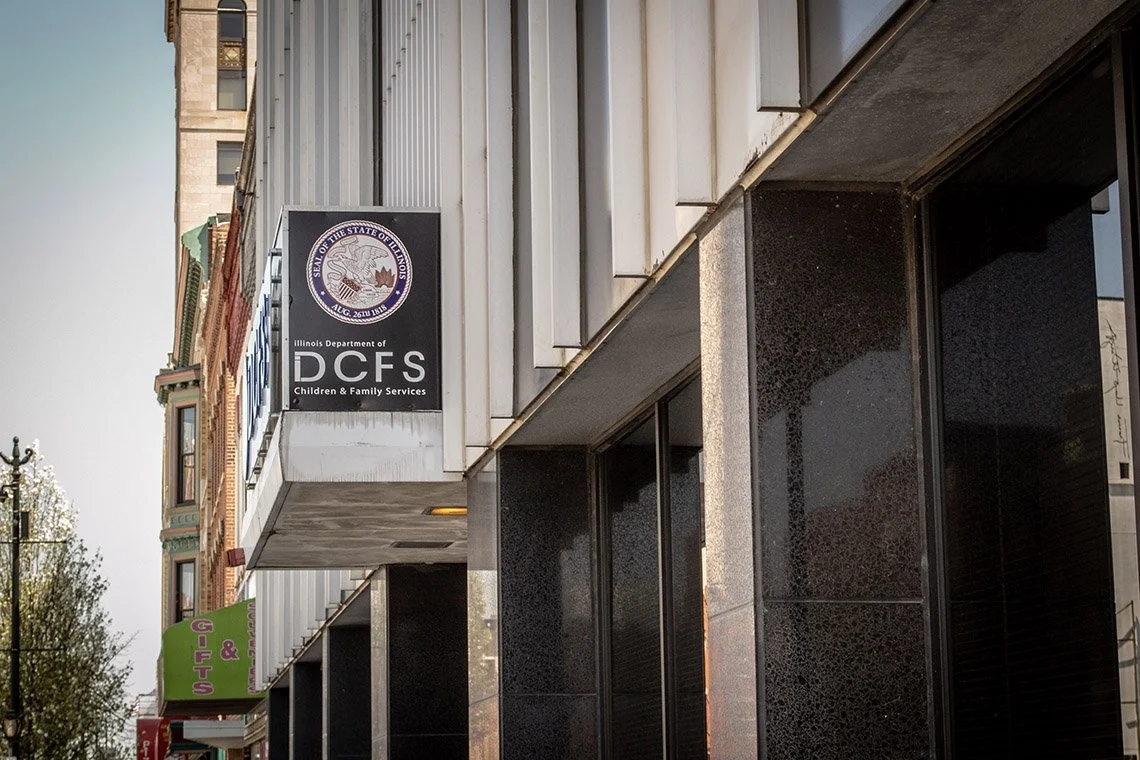By AMALIA HUOT-MARCHAND
Medill Illinois News Bureau
for Capitol News Illinois
amaliahuor-marchand2025@u.northwestern.edu
SPRINGFIELD – Illinois lawmakers could soon make it easier for children in foster care to live with their relatives or other people close to them.
Child welfare experts have long touted the benefits of foster children staying with kin. Advocates say those arrangements offer children more stability, decrease the trauma they experience, improve their mental health and reduce the number of times the child is moved from home to home.
But both state and federal law often made those placements impractical. To get paid to support the children, relatives had to follow the same stringent rules that apply to other foster parents. They go through a rigid home inspection with bedroom size requirements, as well as restrictions on the number of people and gender of individuals who can sleep in the same bedroom. Prospective parents also go through lengthy classroom training.
In 2023, though, the federal government decided to allow states to use separate standards for relatives of children in foster care than for other foster parents, in an effort to pair more children with relatives.
Now, Illinois lawmakers are moving forward with a plan to do just that, along with making other changes that will encourage the placement of children with relatives. The Illinois Senate unanimously approved the measure, known as the Kinship in Demand, or KIND Act, in the fall. But the House must sign off on the changes by the time it adjourns in early January, otherwise the bill must go through the entire legislative process again to reach the governor’s desk.
“I think it's really important that we reckon with how unjust our systems have been in foster care,” said state Sen. Mike Simmons, D-Chicago, one of the bill’s 15 co-sponsors in the upper chamber. “It's an excellent step forward in terms of respecting the integrity of the families these kids come from, that includes their immediate family but also their extended kin that love them.”
Illinois’ record
Close to 10,000 children – or more than half of the total number of kids in the care of the Illinois Department of Children and Family Services – live with family members.
But more than 60% of those families are not eligible for monthly foster care payments, annual clothing vouchers, or foster care support groups according to the ACLU of Illinois.
“Support for kin, for relatives who have not received the same kind of support that foster parents do, for example – I’m talking about monetary support – I think is a very important component of dealing with the amount of time a child spends in the custody of DCFS. We want to make sure they get back to a home environment as fast as they can, and this is a way to encourage that,” said Illinois Gov. JB Pritzker, a Democrat, in a news conference on Dec. 11.
Casey Family Programs, the nation’s largest foundation focused on foster care, states that prioritizing relative caregivers decreases sibling separation, reduces the risk of abuse and gives a higher chance of achieving permanency.
Placing foster children with relatives could also help Illinois do a better job in finding permanent homes for children in its care. Illinois’ foster care system ranked in the bottom third of states in 2019 for children placed in permanent homes, according to the U.S. Department of Health and Human Services. Between 2017 and 2021, the number of children who were placed in a permanent home decreased by 7.8%, according to the 2021 Child Welfare Outcomes Report to Congress.
KIND Act’s changes
The KIND Act would allow DCFS to pursue additional federal funding in order to apply a kin-first approach. DCFS would use the federal money to put more effort into finding families of foster children, notifying them and improving support services, as well as doing background and identity checks.
“By promoting kinship care and addressing systemic issues with a long length of time to permanency and insufficient support of foster care, the KIND Act aims to improve safety, stability and the well-being of children in DCFS care,” state Sen. Mattie Hunter, D-Chicago, a primary sponsor of the bill, said during a November Senate Judiciary Committee hearing.
Payments for relatives particularly impact Black children, who are overrepresented in the foster care system.
In Illinois, as of October, more than 18,000 children were in the DCFS system; more than 8,000 of them were Black. In terms of proportional representation, Black children have a 250% higher chance of being placed in DCFS care, according to the School of Social Work at the University of Illinois Urbana-Champaign.
The poverty rate for Black Illinoisans is 27.7% compared to 8.5% for white Illinoisians. Preventing these families from accessing government subsidies for foster care adds on additional hardships and repeats the cycle of poverty they face, according to the University of Alabama Institute for Human Rights.
“We know that the vast majority of kids who are coming in are overrepresented, and the KIND Act is removing financial barriers for relatives being able to care for kids,” said Nora Collins-Mandeville, director of systems reform policy at the ACLU of Illinois, in an interview.
“Relatives who are coming forward have considerably less resources than a foster parent would. And so the fact that we're not even, in our current system, paying those relatives the same amount that we pay a stranger to care for a child, it's pretty frustrating,” she said.
Under the KIND Act, there would also be a different criminal background criteria for relatives and foster parents. The federal government allows DCFS to waive “non-safety-related licensing” for relative caregivers on a case-by-case basis. Relatives would be subject to a personal analysis assessing their criminal record and its potential impact on the child. The bill would allow DCFS to consider, for example, the overrepresentation of minorities in the prison system, especially for minor drug felonies.
The foster care legislation would also require courts to oversee DCFS’ implementation of the kin-first approach. Courts would have a larger role in family-finding efforts like monitoring whether DCFS complies with notifying relatives that a child has been removed from its parents’ custody within 30 days. Plus, courts would be able to expedite emergency placements of children with relatives who are waiting for a custody hearing.
Contentious history
The bill’s sponsors called the measure historic because of the collaboration between DCFS and the ACLU, which have long fought each other over the state’s care of foster children. In 1988, the ACLU sued DCFS in B.H. v. Johnson. Three years later, both parties entered a consent decree to reform DCFS to provide safer homes, reduce the caseload per employee, protect DCFS funding, allow more supervision and accountability, and improve caseworker training.
These efforts ran into severe obstacles through the years.
A two-year budget stalemate between Democrats in the General Assembly and Republican Gov. Bruce Rauner that ended in 2017 had a major impact on DCFS funding. It forced the agency to close many group homes throughout Illinois. This led to children under DCFS care being housed in places not designed to accommodate children in the long-term, including psychiatric hospitals, juvenile detention centers and shelters and even DCFS offices.
Since then, DCFS struggled to recover from the loss of funds in 2017 and hasn't implemented changes spelled out in the consent decree.
In light of those shortcomings, in 2018, the court appointed a special master to DCFS in order to ensure significant action was taken and to mitigate tensions between the ACLU and DCFS,
Pritzker, who defeated Rauner in the 2018 election, campaigned on the promise to reform the system. Since 2019, the DCFS budget nearly doubled from $1.22 billion to $2.03 billion, mostly to hire more staff and caseworkers. Despite these improvements, a Cook County judge continuously held DCFS director Marc Smith in contempt of court in 2022 for failing to find adequate placements for foster care children, some of whom were still residing in psychiatric hospitals. An appellate court later vacated the contempt citations, and Smith stepped down at the end of 2023. He was the 13th DCFS director in 10 years.
“For a good period of time, there wasn't stability in the agency's leadership at all. We had turnover every year. It wasn't up until the Pritzker administration that we had a director there for multiple years. And so that can be really challenging. You have different priorities for every leader who comes in,” Collins-Mandeville said.
Despite the turnover at the top and the agency’s ongoing court battles, DCFS reduced the number of youths in care from 50,000 in 1995 to 16,000 in 2023. The number, however, has risen in the past year to 18,000.
“Today marks a day that we had long hoped to see: the ACLU and DCFS are in alignment on a piece of landmark legislation that offers an essential opportunity to reform Illinois’ foster care system,” Collins-Mandeville said in her testimony to the Senate committee.
Amalia Huot-Marchand is a graduate student in journalism with Northwestern University’s Medill School of Journalism, Media, Integrated Marketing Communications, and a Fellow in its Medill Illinois News Bureau working in partnership with Capitol News Illinois.
Capitol News Illinois is a nonprofit, nonpartisan news service that distributes state government coverage to hundreds of news outlets statewide. It is funded primarily by the Illinois Press Foundation and the Robert R. McCormick Foundation.







